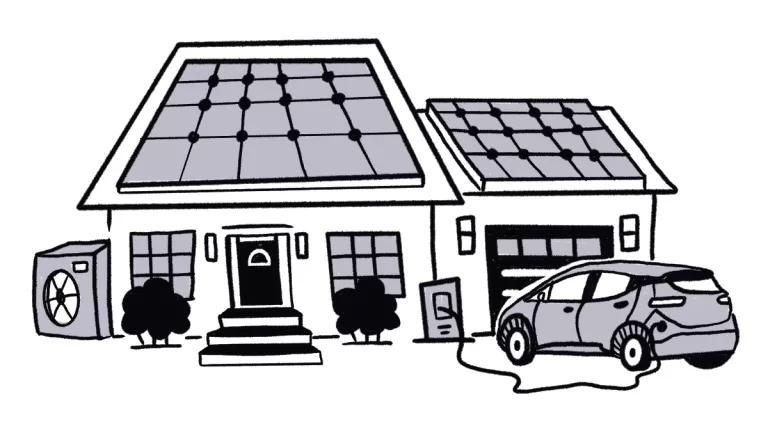Clean Energy Momentum Remains Strong Despite Federal Changes

While the federal landscape has radically shifted, clean energy records are being shattered and climate progress has continued thanks to local action, ever-improving economics, and consumer interest, according to NRDC’s Fifth Annual Energy Report, America's Clean Energy Revolution, published today.
The report includes highlights on renewable energy, energy efficiency, and broader energy and climate trends for 2016 and the first half of 2017. It finds that coal power output continued to fall, as natural gas became the largest source of electricity for the first time and solar, wind, and other renewable power resources reached historic highs. And the rise of clean energy will endure over the next few years thanks to state, local, and corporate commitments.
Our report highlights many major positive trends:
Electricity & Pollution
The electric power sector has seen drastic shifts over the last decade as low-cost natural gas, increasing energy efficiency, and falling renewable power costs push the market towards cleaner technologies. Wholesale energy prices have fallen as cheaper, clean resources enter the market, resulting in a rash of economic coal and nuclear retirements, and producing both consumer bill savings and massive public health and environmental benefits. As coal loses market share in the face of cheaper alternatives, carbon pollution from power plants has declined by 25 percent since 2005. And electric sector emissions were a full 33 percent less than the U.S. Energy Information Administration’s 10-year projection for 2016.
Energy Efficiency
2016 and 2017 have also brought significant gains in efficiency—the most cost-effective way to meet our energy needs, avoid building new fossil power plants, and cut people’s utility bills. In 2016 alone, the U.S. Department of Energy released or updated 11 efficiency standards, which will save consumers over $75 billion over the next decade and a half. Thirteen states also passed new efficiency standards—including building code updates, new utility regulatory structures that promote energy efficiency, and new appliance standards. The wider adoption of these state-level appliance standards could provide $113 billion in savings for consumers and businesses over the next 15 years, and save enough electricity to power 50 million homes and meet the heating needs of half of all Americans for a year.
Renewable Energy
The last year has been a time of historic firsts for renewable energy. At of the end of 2016, wind became the largest source of renewable capacity in the United States, beating out hydropower for the top spot for the first time. America’s first offshore wind farm, Block Island, also began operation in December 2016, producing power off Rhode Island. On the solar front, more than 14 gigawatts (GW) of solar capacity was added—almost double the record-breaking amount in 2015. In fact, America’s 2016 solar energy capacity was 4,500 percent higher than government experts predicted 10 years earlier while the nation’s wind supply was 350 percent above their forecast. And in 2017, for the first time in U.S. history, wind and solar energy made up more than 10 percent of all monthly electric power generation.

State and local policies can lead the way
Despite federal rollbacks to smart carbon and clean energy policies in Washington, D.C., state and local authorities and the private sector continue to embrace the market trends that support pollution-free energy.
Both California and the nine state Regional Greenhouse Gas Initiative in the Northeast and mid-Atlantic regions released strengthened carbon limits, and Colorado and Virginia announced intentions to cap carbon and other greenhouse gas emissions. Oregon passed legislation to eliminate all coal-based electricity, and along with New York, passed new renewable energy standards calling for 50 percent of their electricity to come from renewable power by 2040 and 2030, respectively. Five other states—Illinois, Maryland, Massachusetts, Michigan, and New Hampshire—also enacted or revised their renewable energy standards.
Smaller actors have also been making significant commitments: 377 towns across 44 states have pledged to honor and uphold Paris Climate Agreement goals to cut carbon emissions to keep the increase in global warming below 2 degrees Celsius. Forty of these cities have pledged to go 100 percent renewable. Over 1,700 investors and businesses with operations in America have pledged to work with other U.S. interests to support climate action and meet the goals of Paris. From the start of 2016 to July 2017, corporations procured 3.5 GW of renewable power, which is enough to power 1 million U.S. households every year.
Everyone wins with clean, efficient energy
For the first time since 1960, the average U.S. household spent less than 4 percent of its income on all energy—including gasoline and electricity spending—despite the much larger number of electronic gadgets and appliances we now use. In fact, over the last 35 years, energy spending as a share of U.S. GDP (Gross Domestic Product) has declined by over 50 percent. Not only have energy costs, as a portion of household income and our economy, hit record lows, but the United States has greatly outpaced expectations for a clean, efficient system. The clean energy sector has been growing at a rapid pace, supporting almost 3 million American jobs and contributing the bulk of all new power additions over the past few years. We have reduced our carbon footprint and seen new economic growth and jobs, all while reducing the amount we spend to power our lives and heat our homes, thanks to clean energy.
NRDC’s Fifth Annual Energy Report reaffirms that we don’t have to choose between the environment and a booming economy. A climate-safe future is more affordable and achievable than ever, thanks to the clean energy revolution already underway. (See NRDC’s report, America’s Clean Energy Frontier: The Pathway to a Safer Climate Future, for more on how the U.S. can achieve its long-term climate goals through clean energy).




